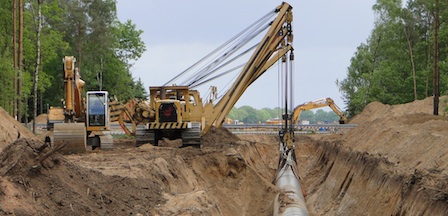Published on

TransCanada’s Energy East pipeline project has been the subject of much discussion in recent weeks. To help you better understand the situation, we’ve put together an overview of the key actions we’ve taken to stop this controversial project.
What is the Energy East project?
The aim of the Energy East pipeline project is to open up the dirty tar sands oil supply to international markets. It would be the largest pipeline in North America—even bigger than the famous Keystone XL project rejected by the Obama administration. This video created by Équiterre and the Council of Canadians is a great synopsis of what is involved in the Energy East project.
Since its creation nearly 25 years ago, Équiterre has worked hard to fight climate change, calling for the phasing out of fossil fuel use and opposing new oil and gas development and transportation projects. For example, working with the residents of Dunham, we put a stop to Enbridge’s Trailbreaker pipeline and, from the start, we have fought fiercely against the Energy East project. We’ve held dozens of public meetings to oppose the project—mostly in Quebec, but also in Manitoba, Ontario and New Brunswick. Some of these meetings led to the emergence of anti-Energy East community groups, many of which have joined the Mouvement STOP Oléoduc [Stop The Pipeline Movement].
Growing opposition
The groundswell of opposition to the project could well thwart TransCanada’s plans. For three years now, community groups have been rallying across Quebec and in other provinces. Many municipalities and Indigenous groups have also taken a stand against the project because of the increased risk of spills, which would threaten drinking water sources. The Communauté métropolitaine de Montréal (CMM), which represents over 3 million people, came out against the project in autumn 2015. Even the Canadian military has voiced concerns. The Quebec Federation of Labour (FTQ), which represents 600,000 workers, has also objected to the project, calling for the development of jobs that support sustainable development goals.
As well as organizing the largest anti-Energy East petition in Canada in 2014-2015, which gathered 90,000 signatures, Équiterre has contributed enormously to the success of large-scale protest marches, including those in Quebec City and Ottawa in 2015, and even the one in New York in 2014. You can find extensive information on the Energy East project on our website. Check it out!
Who can authorize the pipeline?
In theory, the federal government has the final say. However, to quote Justin Trudeau: “Even though governments grant permits, only communities grant permission.”
So what are the roles of the Bureau d’audiences publiques sur l’environnement (BAPE) and the National Energy Board (NEB) in all this?
The BAPE hearings started in April this year. Many groups, including Équiterre, claimed the BAPE hearings would be incomplete, as TransCanada had not complied with the provisions of Quebec’s Environment Quality Act, and a motion for a declaratory judgment was filed against TransCanada. TransCanada then had a change of heart when the BAPE process was already underway. The Minister of the Environment decided to suspend the hearings so that complete hearings could be held, leaving over 300 briefs, including Équiterre’s, unheard. We’re still waiting for the hearings to begin again.
As for the NEB, it is a regulatory agency, whose mandate was revised under the Harper government. As well as having quasi-judicial powers (its decisions can influence rights), the NEB has conducted environmental assessment hearings on pipeline projects since 2012—a mandate previously assigned to the Canadian Environmental Assessment Agency. The Trudeau government promised to reform the NEB’s mandate, but Energy East will not be subject to these new measures. The NEB’s hearings on Energy East thus started in June, despite the fact that important information is missing from TransCanada’s application, including how the pipeline will cross the Ottawa and St. Lawrence rivers. Équiterre is taking part in the current NEB hearings, as it did for Enbridge’s Line 9a and 9b pipeline projects.
A Flawed process
On the first day of the NEB’s hearings, the media revealed that the NEB board chairman and two of the three Energy East review panellists had met privately before the hearings. The problem? Former Quebec premier Jean Charest, at that time an Energy East lobbyist, was at the meeting, and they discussed TransCanada’s application. Many other organizations, including Équiterre, First Nations groups and municipal representatives also met the NEB to discuss pipeline safety and environmental protection. However, these meetings were not private and were even noted in an NEB online report published in January 2016.
Various groups requested that the two review panellists involved recuse themselves (not take part in the current hearings) and Équiterre supported these calls. In light of these serious, well-founded complaints, the NEB suspended the hearings to assess the situation and the review panellists finally stepped down. The NEB process is therefore on hold until new panellists are appointed. Over 50 organizations, including Équiterre, are now calling for an in-depth reform of the NEB.
The story continues as the fight is far from over!




